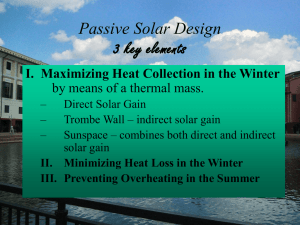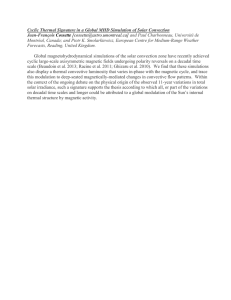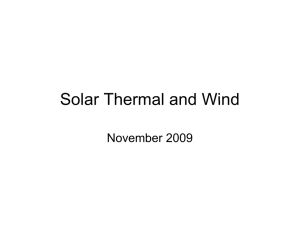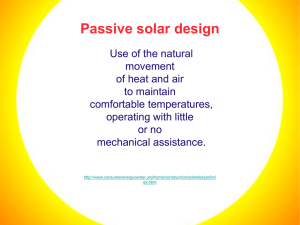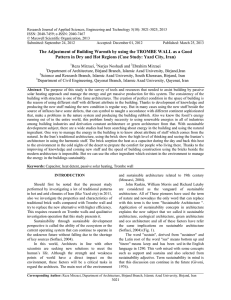Simulation and Numerical Investigation of Web Site: www.ijaiem.org Email:
advertisement
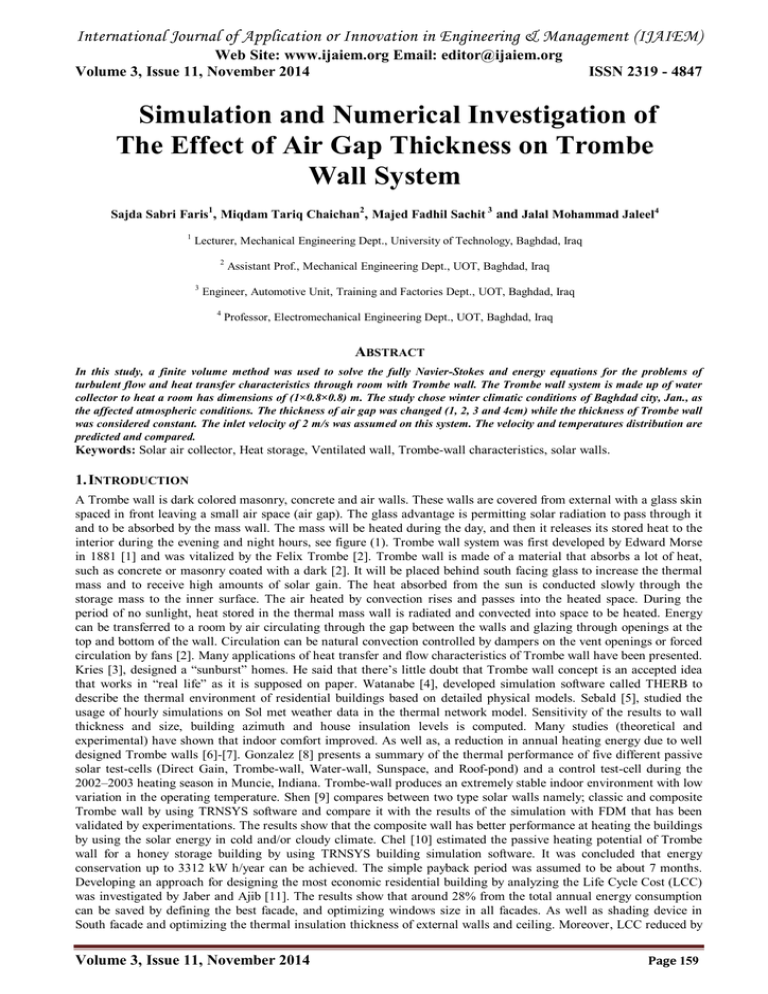
International Journal of Application or Innovation in Engineering & Management (IJAIEM) Web Site: www.ijaiem.org Email: editor@ijaiem.org Volume 3, Issue 11, November 2014 ISSN 2319 - 4847 Simulation and Numerical Investigation of The Effect of Air Gap Thickness on Trombe Wall System Sajda Sabri Faris1, Miqdam Tariq Chaichan2, Majed Fadhil Sachit 3 and Jalal Mohammad Jaleel4 1 Lecturer, Mechanical Engineering Dept., University of Technology, Baghdad, Iraq 2 3 Assistant Prof., Mechanical Engineering Dept., UOT, Baghdad, Iraq Engineer, Automotive Unit, Training and Factories Dept., UOT, Baghdad, Iraq 4 Professor, Electromechanical Engineering Dept., UOT, Baghdad, Iraq ABSTRACT In this study, a finite volume method was used to solve the fully Navier-Stokes and energy equations for the problems of turbulent flow and heat transfer characteristics through room with Trombe wall. The Trombe wall system is made up of water collector to heat a room has dimensions of (1×0.8×0.8) m. The study chose winter climatic conditions of Baghdad city, Jan., as the affected atmospheric conditions. The thickness of air gap was changed (1, 2, 3 and 4cm) while the thickness of Trombe wall was considered constant. The inlet velocity of 2 m/s was assumed on this system. The velocity and temperatures distribution are predicted and compared. Keywords: Solar air collector, Heat storage, Ventilated wall, Trombe-wall characteristics, solar walls. 1. INTRODUCTION A Trombe wall is dark colored masonry, concrete and air walls. These walls are covered from external with a glass skin spaced in front leaving a small air space (air gap). The glass advantage is permitting solar radiation to pass through it and to be absorbed by the mass wall. The mass will be heated during the day, and then it releases its stored heat to the interior during the evening and night hours, see figure (1). Trombe wall system was first developed by Edward Morse in 1881 [1] and was vitalized by the Felix Trombe [2]. Trombe wall is made of a material that absorbs a lot of heat, such as concrete or masonry coated with a dark [2]. It will be placed behind south facing glass to increase the thermal mass and to receive high amounts of solar gain. The heat absorbed from the sun is conducted slowly through the storage mass to the inner surface. The air heated by convection rises and passes into the heated space. During the period of no sunlight, heat stored in the thermal mass wall is radiated and convected into space to be heated. Energy can be transferred to a room by air circulating through the gap between the walls and glazing through openings at the top and bottom of the wall. Circulation can be natural convection controlled by dampers on the vent openings or forced circulation by fans [2]. Many applications of heat transfer and flow characteristics of Trombe wall have been presented. Kries [3], designed a “sunburst” homes. He said that there’s little doubt that Trombe wall concept is an accepted idea that works in “real life” as it is supposed on paper. Watanabe [4], developed simulation software called THERB to describe the thermal environment of residential buildings based on detailed physical models. Sebald [5], studied the usage of hourly simulations on Sol met weather data in the thermal network model. Sensitivity of the results to wall thickness and size, building azimuth and house insulation levels is computed. Many studies (theoretical and experimental) have shown that indoor comfort improved. As well as, a reduction in annual heating energy due to well designed Trombe walls [6]-[7]. Gonzalez [8] presents a summary of the thermal performance of five different passive solar test-cells (Direct Gain, Trombe-wall, Water-wall, Sunspace, and Roof-pond) and a control test-cell during the 2002–2003 heating season in Muncie, Indiana. Trombe-wall produces an extremely stable indoor environment with low variation in the operating temperature. Shen [9] compares between two type solar walls namely; classic and composite Trombe wall by using TRNSYS software and compare it with the results of the simulation with FDM that has been validated by experimentations. The results show that the composite wall has better performance at heating the buildings by using the solar energy in cold and/or cloudy climate. Chel [10] estimated the passive heating potential of Trombe wall for a honey storage building by using TRNSYS building simulation software. It was concluded that energy conservation up to 3312 kW h/year can be achieved. The simple payback period was assumed to be about 7 months. Developing an approach for designing the most economic residential building by analyzing the Life Cycle Cost (LCC) was investigated by Jaber and Ajib [11]. The results show that around 28% from the total annual energy consumption can be saved by defining the best facade, and optimizing windows size in all facades. As well as shading device in South facade and optimizing the thermal insulation thickness of external walls and ceiling. Moreover, LCC reduced by Volume 3, Issue 11, November 2014 Page 159 International Journal of Application or Innovation in Engineering & Management (IJAIEM) Web Site: www.ijaiem.org Email: editor@ijaiem.org Volume 3, Issue 11, November 2014 ISSN 2319 - 4847 11.94% from the proposed base case. Stazi [12] studied the thermal behavior of Trombe walls in summer under Mediterranean climate conditions. The study focused on changing of shading, ventilation and operational conditions to determine experimentally the thermal parameters of a Trombe wall in summer conditions. The results showed that shading, ventilation and occupancy conditions affect the thermal parameters of Trombe wall in summer significantly. Figure 1 Construction element of the massive wall The aim of this study is to evaluate numerically the effects of air gap thickness between the glass and wall on the thermal parameters of Trombe wall in Baghdad wintertime conditions. Also, to verify air movement and thermal distribution through the room. In this study, the problems of heat transfer and flow during Trombe wall in a room is solved by a finite volume method. Two-dimensional, the algorithm simple [13] was used in this work. The problem with Navier-stokes equations were written in terms of primitive variables method (u, v, p). The transient heat conduction is connected with convection in room and Trombe wall are applied in this work. The formulation of transient heat conduction problems involves an additional term representing the change the energy content of the room walls and Trombe walls with time. 2.THEORETICAL PART Heat transfer through the wall was considered unsteady while natural convection was considered steady. This was conducted by carrying natural convection out every three hours to keep up with wall time changes. In the theoretical study and due to the applied assumptions that simplifies the solution (like: considering natural convection is steady, and the wall is insulated) the maximum room temperature delayed to 3 PM. In the other hand, in real practical study this is not the situation. The room small size and imperfect insulation makes the room temperature changes quickly with solar intensity. The mean flow equations for continuity, momentum and energy may be expressed for steady state conditions in the following conservative from as: ( u ) ( v ) 0 x y (1) p u u eff eff (uu ) (uv ) x y x x x y y u v eff eff x x y x (2) p v v eff eff (uv ) (vv ) x y y x x y y u v eff eff g( T TO ) x y y y Volume 3, Issue 11, November 2014 (3) Page 160 International Journal of Application or Innovation in Engineering & Management (IJAIEM) Web Site: www.ijaiem.org Email: editor@ijaiem.org Volume 3, Issue 11, November 2014 u v x y x x y y u' ' v ' ' x y ISSN 2319 - 4847 (4) Turbulence model ( k ) The k model characterizes the local state of turbulence by two parameters: the turbulent kinetic energy, k, and the rate of its dissipation . The turbulent viscosity is related to these parameters by the Kolmogorov-Prandtl expression: (5) t C k 2 / Where C is an empirical constant. The distribution of k and over the flow field is calculated from the following semi-empirical transport equation for k and . Turbulence energy k : k k K K (uk ) (vk ) x y x x y y u 2 t 2 x Dissipation rate v y 2 u v 2 y x (6) : C1 t (u ) ( v ) x y x x y y k u 2 v 2 u v 2 2 C 2 2 k y y x x (7) The values of the empirical constant used here are given in table (1). These values are recommended by Launder and Spalding [7]. Table (1) Values of constants in the ( k ) model C K C1 C 2 0.09 1.00 1.30 1.44 1.92 Initial and Boundary Conditions In order to start the computations, some initial conditions have to be set at time (t = 0.0). These initial conditions are specified at all grid points for dimensional variables in turbulent flow. In this study, the solution is highly dependent on these initial conditions. 3.NUMERICAL SOLUTION Numerical procedure called SIMPLE is used to solve the basic conservative and turbulence equations (momentum, heat mass, turbulent kinetic energy and rate of dissipation) by using a hybrid scheme [14]. The finite volume mesh consists of many control volume using a staggered grid system. All scalar quantities such as pressure and temperature are defined at any two grid intersecting lines. The U, V velocity components are defined on the scalar control volume faces see the figure (2) below. Let be any property for which the conservation equations is as follows: Volume 3, Issue 11, November 2014 Page 161 International Journal of Application or Innovation in Engineering & Management (IJAIEM) Web Site: www.ijaiem.org Email: editor@ijaiem.org Volume 3, Issue 11, November 2014 ISSN 2319 - 4847 Figure 2 Two-dimensional staggered shown the locations of the discredited variables S ( u ) ( v ) x y x x y y (10) After applying central difference for the diffusion terms and a hybrid scheme for convection terms and discretizing the finite volume for the control volume, Let be any property for which the discretized equations is as follows: A P P A E E A W W A N N A S S S where :Ap ,Aw ,Ae ,As and An coefficient of (11) p , w , e , s and n 4.RESULTS AND DISCUSSIONS Results are obtained numerically for incompressible flow under the conditions illustrated in the foregoing sections. The thermal characteristics and flow field discussed separately. One of the problematic points of Trombe wall designing is choosing the optimal air gap thickness. Heat distribution with various thicknesses affects the transferred sensible heat. Figure (3) illustrated air gap thickness of 1 cm. This thickness is too little, and it will be heated by solar radiation easily causing an additional load on the heating system of the building. In addition, solar radiation will be stored in a concrete wall as sensible energy in order to use it at night and vice versa. Accordingly, heat distribution at air gap thickness equal 1 cm will constantly decrease from starting point at 0 hr (12 PM) until it reaches its minimum value at 8 AM. In this period, the air heated by the storage thermal energy in the wall. At 8 PM and on, sun rises and it will heat and raises the wall temperature and in the same time the air restricted in the gap. However, this heat is not enough for heating purpose that’s why the room temperature still lower than comfortable conditions. As a result, the stored thermal energy in the wall will increase with time as well as the air in the gap. However, the relation between temperature in specified time and the thickness of the air gap will be a reversible relation. Whenever the thickness increases, the stored heat in the air is reduced and then reduced in room. The figure indicates that the stagnant core region which represents the center of the room (where losses are very high) the heat and the buoyancy forces becomes dominant and increases by reducing speed. When solar radiations fall onto the glass surface, the wall absorbs these radiations. Accordingly the wall temperature will rise and the wall will be heated causing the air in room to be heated too. The heat transfers from the internal surface of the wall to the in-room air by means of convection. The existence of vents at the top and bottom of the wall helps in air movement through these vents. The air gap will be situated between the external surface of the wall and the internal surface of the glass layer. We can see that heat transfer of in-room air is done by convection through the vents by force of convection and means of fans in these vents. Inside the room, heat transfers in Trombe wall is made by conduction and through the room by convection. Air will be heated to rise upwards in return cold air will move downwards by the influence of buoyancy forces. The free convection will increase when speed reduces. Accordingly we can realize three factors which are dominant in regions of Trombe wall system. Volume 3, Issue 11, November 2014 Page 162 International Journal of Application or Innovation in Engineering & Management (IJAIEM) Web Site: www.ijaiem.org Email: editor@ijaiem.org Volume 3, Issue 11, November 2014 ISSN 2319 - 4847 Figure 3 Hourly variation of contours temperature distribution of optimal Uin=2 m/s and air gap thickness= 1 cm in a room and Trombe wall for light concrete material during a clear day The computer program is designed in terms of different thicknesses between (1-4) cm and for the used material in heat storage. It is found that the maximum air temperature achieved in Trombe wall system (16) o’clock (4 pm) and has the highest value of (26) oC as illustrated in figure (3). Also at this time the air movement is more uniform and smooth compared with other studied time periods like period C-(8-12) hr, as figure (4) illustrates. Figure 4 Flow field (U&V velocity vectors) for turbulent flow Uin=2m/s, in a room and Trombe wall of concrete material and air gap thickness=1 cm Figure (5) represents heat distribution in the room of the six time periods of heat storage when the air gap thickness is 3 cm. Increasing air gap thickness reduced the heating rate of air due to more air restricted in the gap per time interval compared with air gap thickness of 1 cm. The maximum air temperature achieved is 21oC which is less than the previous case. Also, it reached its maximum value at advanced period (12-16) hr. It provides less stable temperatures during night hours because of the air have low thermal conductivity and the convection heat transfer for more air reduces the acquired heating. Recent study is conducted by using the climatic conditions of a sunny day in the winter month namely, in January. It is important to mention here that choosing any other day for this purpose will not affect Volume 3, Issue 11, November 2014 Page 163 International Journal of Application or Innovation in Engineering & Management (IJAIEM) Web Site: www.ijaiem.org Email: editor@ijaiem.org Volume 3, Issue 11, November 2014 ISSN 2319 - 4847 the value of the optimal air gap thickness. However, it will affect the quantity of the maximum heat storage according to the intensity of solar radiation and the outer temperature in that day. Figure 5 Hourly variation of contours temperature distribution of optimal Uin=2m/s and air gap thickness= 3 cm in room and Trombe wall for light concrete material during a clear day Figure (6) illustrates air distribution in the room at air gap thickness of 3 cm. It can be said that little air gap thickness may be suitable for buildings that require a fast utilizing of solar radiation in heating and a specific time. Figure (7) represents the fluctuation of temperature in the Trombe Wall system with air gap thickness of 4cm. Heat distribution in the room reduces in this case. In the same time, the maximum air temperature achieved was lower than 3 cm thickness. The maximum achieved temperature was 18oC. Increasing air gap increases air quantity restricted in the gap per time, reducing the gained heat. As a result, reduces the air temperature. This lower air temperature reflects on air movements and distribution inside the room, as figure (8) declares. Volume 3, Issue 11, November 2014 Page 164 International Journal of Application or Innovation in Engineering & Management (IJAIEM) Web Site: www.ijaiem.org Email: editor@ijaiem.org Volume 3, Issue 11, November 2014 ISSN 2319 - 4847 Figure 6 Flow field (U&V velocity vectors) for turbulent flow Uin=2m/s, in a room and Trombe wall of concrete material and air gap thickness=3 cm Figure 7 Hourly variation of contours temperature distribution of optimal Uin=2m/s and air gap thickness= 4 cm for light concrete material during a clear day Volume 3, Issue 11, November 2014 Page 165 International Journal of Application or Innovation in Engineering & Management (IJAIEM) Web Site: www.ijaiem.org Email: editor@ijaiem.org Volume 3, Issue 11, November 2014 ISSN 2319 - 4847 Figure 8 Flow field (U&V velocity vectors) for turbulent flow Uin=2m/s, in a room of concrete material and air gap thickness=4 cm The former figures clarify that the air gap in which air-speed is very high and regular as a result of initial forces that increase when velocity increases depends on two factors. First the temperature differences between hot and cold air. Secondly, the air gap thickness, air speed increases with reducing the air gap. Figures 9, 10 and 11 illustrate the temperature cantor lines distributions in the Trombe wall and the space. There is a remarkable temperatures increase inside the room. Also, there is a temperature fluctuation can be seen in the room during the charging hours. Vents must be used to lessen these fluctuations and supply comfort conditions. Figure 9 Temperatures cantor lines distribution for air gap=1 cm Figure 10 Temperatures cantor lines distribution for air gap=3 cm Figure 11 Temperatures cantor lines distribution for air gap=4 cm 5.CONCLUSSIONS Using of heating technique by passive solar energy is a very appropriate and practical process in the heat storing by using Trombe wall. This study has shown the capability of a CFD code to predict the conduction and natural convection in Trombe wall system. The CFD simulations on the meshed structure were used. Recent study was conducted to evaluate the optimal air gap thickness for Trombe Wall System. Three air gap thicknesses were studied (1, 3 and 4 cm). Volume 3, Issue 11, November 2014 Page 166 International Journal of Application or Innovation in Engineering & Management (IJAIEM) Web Site: www.ijaiem.org Email: editor@ijaiem.org Volume 3, Issue 11, November 2014 ISSN 2319 - 4847 The atmospheric conditions of Baghdad city wintertime was used to evaluate heat stored and distribution in assumed room of (1×0.8×0.8) m. The results of the numerical calculations conclude that: 1-The air gap in which air speed is very high and regular as a result of initial forces that increase when velocity increases. 2-Vents region increases when initial forces increase, that is when air movements increases. Air velocity increases are depending on air gap thickness where the convection force becomes prominent. 3-The stagnant core region represents the center of the room where losses are very high, heat increases and the buoyancy forces becomes dominant and increases by reducing speed. 4- Air gap thickness of 1 cm indicates a better room heat distribution and air movements than other studied gaps. 5- At 7:30 in the morning, the heat storage of Trombe wall is fully released. Temperature at this moment reaches its minimum. At 4:00 PM, the temperature achieves its maximum. 6- There is a remarkable temperature increase inside the room. There is a temperature fluctuation can be seen in the room during the charging hours. Vents must be used to lessen these fluctuations and supply comfort conditions. It can be seen from the figures that reducing the glass-wall gap increased temperature distribution. REFERENCES [1] E. Morse, "Warming and Ventilating Apartments by Sun’s Rays" US Patent No. 246,626, 1881. [2] J. Duffie & W. Beckman, "Solar Engineering of Thermal Processes", John Wiley and Sons, Inc. 2006. [3] J. Kries, "The Sun Burst Solar Home", Stackpole Books, pp.240, 1979. [4] T. Watanabe, A. Ozak, "Practical Method for Calculating Unsteady-State Heat Conduction of Multi-Layer Walls Based on Pulse Transfer Function", Journal of Architectural Institute of Japan, vol. 391, 1997. [5] A.V. Sebald, J.R. Clinton, F. Langenbacher, "Performance effects of Trombe wall control strategies", Department of Applied Mechanics and Engineering Sciences and Energy Center, University of California, San Diego, La Jolla, CA 92093, U.S.A. [6] J. Jie, Y. Hua, H. Wei, P. Gang, L. Jianping, J. Bin, 'Modeling of a novel Trombe wall with PV cells", Building and Environment, vol. 42, No. 3, pp: 1544–1552, 2007. [7] T.G. Zbalta, S. Kartal, "Heat Gain through Trombe Wall Using Solar Energy in a Cold region of Turkey", Scientific Research and Essays, vol. 5, No. 18, pp: 2768–2778, 2010. [8] F.A. Gonzlez, "Analysis of the Thermal Performance and Comfort Conditions Produced by Five Different Passive Solar Heating Strategies in the United States Mid-West", Solar Energy, vol. 81, No. 5, pp: 581–593, 2007. [9] J. Shen, S. Lassue, L. Zalewski & D. Huang, "Numerical Study of Classical and Composite Solar Walls by TRNSYS", Journal of Thermal Science, vol. 16, pp: 46–55, 2007. [10] A. Chel, J. Nayak, G. Kaushik, "Energy Conservation in Honey Storage Building Using Trombe wall", Energy and Buildings, vol. 40, No. 9, pp: 1643–1650, 2008. [11] S. Jaber, S. Ajib, "Optimum Design of Trombe Wall System in Mediterranean Region", Solar Energy, vol. 85, pp: 1891–1898, 2011. [12] F. Stazi, A. Mastrucci & C. di Perna, "Trombe Wall Management in Summer Conditions: An Experimental Study", Solar Energy, vol. 86, pp: 2839–2851, 2012. [13] L. Zalewski, S. Lassue, B. Duthoit & M. Butez, "Study of Solar Walls Validating a Simulation Model", Building and Environment, vol. 37, No. 1, pp: 109–121, January 2002. [14] Fraisse G, Johannes K, Trillat-Berdal V & Achard G, The use of a heavy internal wall with a ventilated air gap to store solar energy and improve summer comfort in timber frame houses, Energy and Buildings, vol. 38, No. 4, pp: 293–302, 2006. AUTHORS Sajeda Sabri Faris received the B.S. and M.S. degrees in Mechanical Engineering from Mechanical Eng. Dept., UOT in 1997 and 1999, respectively. Since 1999, she taught in Mechanical Eng. Dept., UOT, Baghdad, Iraq, She investigated in ICE and Alternative and Sustainable Energy. She is now Lecturer in Mechanical Engineering Dept., University of Technology; Baghdad, Iraq. Miqdam Tariq Chaichan received the B.S. in Mechanical Engineering from Baghdad University in 1982 and M.S. degrees in Power Generation from University of Technology in 1989. Since 1999, he tough in several universities and investigated in many fields like fuel and combustion, ICE, alternative fuels, Solar and Sustainable Energy. He is now Assistant Professor in Mechanical Engineering Dept., University of Technology; Baghdad, Iraq. Volume 3, Issue 11, November 2014 Page 167 International Journal of Application or Innovation in Engineering & Management (IJAIEM) Web Site: www.ijaiem.org Email: editor@ijaiem.org Volume 3, Issue 11, November 2014 ISSN 2319 - 4847 Majed Fadhil Sachit received the B.S. in Mechanical Engineering from University of Technology in 2005. Since 2006 he taught in Automotive Unit, Training and Factories Dept., UOT, Baghdad, Iraq. Jalal Mohammad Jaleel received B.S. in Mechanical Engineering from the University of Technology, and M.S. and Ph D degrees in mechanical engineering from Liverpool University 1980. Since 1980, he tough in several universities and investigated in many fields like alternative fuels, Solar and Sustainable Energy and CFD. He is now Professor in Electromechanical Engineering Dept., University of Technology; Baghdad, Iraq. Volume 3, Issue 11, November 2014 Page 168
